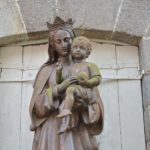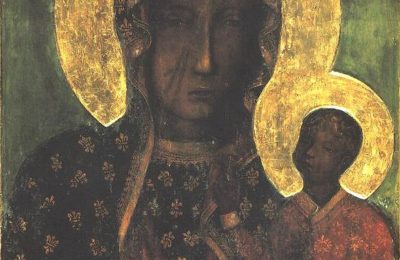I was recently reading about the Chartres Cathedral, located in Chartres, France, and found a notation stating that the cathedral was slated for destruction by American forces during World War II, as they thought it was being used by German forces as a post for snipers; but this grand 12th century Catholic cathedral was saved by one American Army officer from Texas named, Colonel Welborn Barton Griffith, Jr. (b. November 19, 1901 – d. August 16, 1944). The cathedral was saved by Colonel Griffith on August 16, 1944, which is also the day of his death. Hours after saving the Chartres Cathedral, his blood was spilled on a street in France, far from his American homeland, spilled to free the French people from unlawful occupiers. I read further about Colonel Griffith, and found the most complete retelling of the events of his life in the newsletter of the Texas State Historical Association, and it reads as follows:
Welborn Barton Griffith, Jr., was a United States Army officer, recognized for his heroics in Chartres, France, during World War II in saving Chartres Cathedral. Griffith was born in Quanah, Texas, in a family of five children to Welborn B. Griffith, Sr., and Lula Love (Smith) Griffith on November 10, 1901. Griffith attended Texas A&M University and the United States Military Academy at West Point where he played tackle on the Army football team. He also earned a reputation for his skills as a horseman, a rifle sharpshooter, and a pistol marksman. Before graduating from West Point in 1925, Griffith also participated in boxing, wrestling, and lacrosse. In 1929 Griffith married Alice Torrey, the daughter of an army officer, at Fort Benning, Georgia, where he had graduated from Infantry School. The couple’s only child Alice was born in 1931.
In the 1930s Griffith was sent to the Philippine Islands for a short time and then to Shanghai, China, where he was assigned to the Chinese Army as an observer. During his tour in China, Griffith traveled to Japan where he backpacked across the country and took photographs. Suspicious of his activities, Japanese authorities briefly jailed him. After his first marriage ended in divorce, Griffith married Nell Humphrey of Brooklyn, New York, in 1940.
With the United States entering World War II in late 1941, Griffith devoted the rest of his life to preparing soldiers for combat. After serving as an instructor at the Command and General Staff School in Fort Leavenworth, Kansas, Colonel Griffith was assigned as the operations officer (G-3) to the IV Armored Corps Headquarters at the Desert Training Center in California in 1943. He worked with battle operations and training exercises for the organization that prepared it for desert warfare in North Africa. The Corps devoted most of 1943 to battle training first in the California desert and then at Camp Campbell, Kentucky. With the end of the desert war in North Africa, Griffith shifted his focus on military training and operations for the invasion of Western Europe. The organization also changed its name from the IV Armored Corps to the XX Corps, because it included armored and infantry divisions as well as other units. In February 1944, XX Corps departed for England on the Queen Mary and arrived in five days. From its new camp in Wiltshire County in southern England, the Corps devoted the next several months training for D-Day. On July 22, 1944, XX Corps landed on the beaches of Utah beach in the French province of Normandy.
By August, XX Corps was attached to the Third Army commanded by Gen. George S. Patton, Jr. In early August the XX Corps entered combat and succeeded in pushing German forces in northern France back to the city of Chartres, where the American Seventh Armored Division encountered fierce resistance from the Germans. On the morning of August 16, 1944, Colonel Griffith, XX Corps commander Gen. Walton Walker, and other officers were informed about German machine gun and mortar emplacements occupying strategic spots in Chartres. During this briefing, Griffith learned that XX Corps Artillery had orders to destroy the medieval Chartres Cathedral.
Situated in the city of Chartres southwest of Paris, Notre-Dame de Chartres Cathedral has been heralded as a masterpiece of architecture and sculpture. The cathedral’s original construction dates back to the 1140s, and major reconstruction after a fire occurred mostly between 1194 and 1223. The World Heritage Centre has described it as “the high point of French Gothic art.” Consecrated in 1260, the cathedral combines elements of both Romanesque and Gothic architecture in its twin towers. On August 16, 1944, the XX Corps, believing the Germans were occupying the twin towers, ordered the edifice destroyed.
After the staff meeting, Colonel Griffith decided to go to Chartres and determine if German forces occupied Chartres Cathedral. Along with his jeep driver, he entered the city and drove to the cathedral. Griffith witnessed a number of American soldiers firing at the cathedral but saw no return fire. He questioned the solders’ actions, but they contended German snipers were firing from the spires of the edifice. Unconvinced, the Texan walked into the cathedral and found no Germans in the various compartments. After inspecting both steeples, he climbed to the top of the bell tower, rang the bell, and hung an American flag from the belfry. After leaving the cathedral, Griffith sent an order to the artillery group not to destroy the cathedral.
Griffith then ordered his driver to head to the village of Lèves, a suburb of Chartres, on the main road to Paris. On this road, he encountered a German patrol of around fifteen men. After returning hostile fire from the Germans, Colonel Griffith ordered his driver to return to Chartres where he encountered a tank from the Seventh Armored Division. Griffith ordered the tank crew to proceed to the location where he engaged the Germans. He climbed on the back of the tank behind the turret and held a pistol in his left hand and a rifle in his right. As the tank moved through the streets of Lèves, it came under attack from machine gun, rifle, and rocket launcher fire. From the intense fire, Colonel Griffith was struck in the back and was killed instantly.
Eyewitnesses to the exchange indicated that two French boys moved Griffith’s body where it had fallen off the tank into the street to the sidewalk. Residents of the village then placed a blanket over the body, flowers, as well an American flag. Villagers later placed chairs by the slain Texan and held a vigil that night until American forces arrived the following morning and removed the body. XX Corps staff officers made the arrangements for Colonel Griffith to be buried with full military honors in a temporary cemetery at Savigny-sur-Braye beside other American soldiers. He was later buried at the Brittany American Cemetery and Memorial near the village of St. James. For his heroics on August 16, 1944, Colonel Griffith was awarded the Distinguished Service Cross, the Silver Star, the Purple Heart, the French Croix de Guerre avec Palm, the Legion of Merit, and the Legion of Honor.
In northern France, the American army officer’s efforts to save Chartres Cathedral is still honored years after the war. At the site where he died, in 1961 a plaque was placed on the front of a building that honors his efforts. Based on Griffith’s dog tags, French citizens mistakenly thought that his surname was Welborn (spelled Welburn on the plaque), but in the 1990s local Lèves historian and museum founder Bertrand Papillon discovered the mistake and eventually established contact with the Griffith family. On August 16, 1995, fifty-one years after the death of Col. Welborn Barton Griffitih, Jr., the citizens of Lèves conducted a ceremony to honor and remember his heroics of August 16, 1944. They dedicated a new plaque, and Griffith’s daughter Alice and other members of the Griffith family attended the memorial service held at Chartres Cathedral. During the memorial, Dean of the Cathedral Canon François Legaux acknowledged the actions of Griffith: “The only tomb worthy of a hero is in the hearts of the living…this is true today as we keep in our hearts the name of Colonel Welborn Griffith.” For the first time in its history, the great organ played the “Star Spangled Banner.” A few years later, the village of Lèves established a park that was dedicated to the Texas native and his memory.
On August 16, 2014, the American Friends of Chartres honored Griffith with the laying of a wreath by its president Dominique Lallement at the Houston National Cemetery. (source)
What an amazing story of an American hero.
May Colonel Griffith, rest in peace.
~SCF
~Image: facade of the Chartres Cathedral, France.
*Update, 10/27/21- it has come to our attention that Chartres Cathedral was also saved from demolition on another occasion: at the end of WW II, as the Germans withdrew from France, they set explosives in Chartres Cathedral to demolish it. These explosives were disarmed by a member of the U.S. Army, Leonard H. Smith. His biography may be read here.






